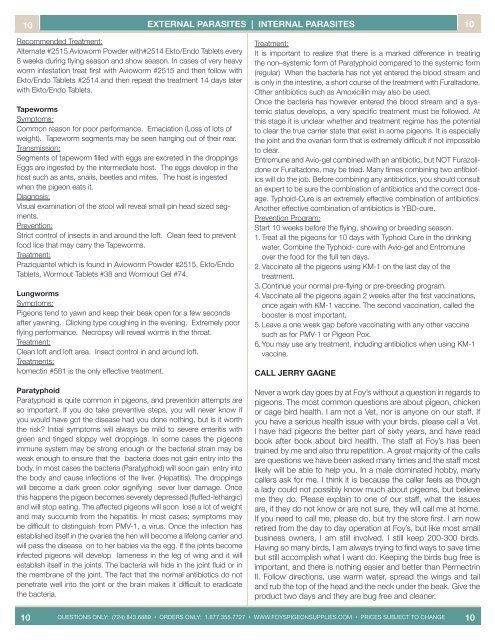2018-2019 Foy's Pet Supplies Catalog
The 2018-2019 Foy's Catalog contains pigeon and chicken products as well as descriptions and directions for products we currently carry. Not only is it full of products, but also with tips from Jerry, stories about Foy's and a meet the staff section.
The 2018-2019 Foy's Catalog contains pigeon and chicken products as well as descriptions and directions for products we currently carry. Not only is it full of products, but also with tips from Jerry, stories about Foy's and a meet the staff section.
Create successful ePaper yourself
Turn your PDF publications into a flip-book with our unique Google optimized e-Paper software.
10 EXTERNAL PRICES PARASITES SUBJECT | INTERNAL TO CHANGE PARASITES<br />
10<br />
Recommended Treatment:<br />
Alternate #2515 Avioworm Powder with#2514 Ekto/Endo Tablets every<br />
8 weeks during flying season and show season. In cases of very heavy<br />
worm infestation treat first with Avioworm #2515 and then follow with<br />
Ekto/Endo Tablets #2514 and then repeat the treatment 14 days later<br />
with Ekto/Endo Tablets.<br />
Tapeworms<br />
Symptoms:<br />
Common reason for poor performance. Emaciation (Loss of lots of<br />
weight). Tapeworm segments may be seen hanging out of their rear.<br />
Transmission:<br />
Segments of tapeworm filled with eggs are excreted in the droppings<br />
Eggs are ingested by the intermediate host. The eggs develop in the<br />
host such as ants, snails, beetles and mites. The host is ingested<br />
when the pigeon eats it.<br />
Diagnosis:<br />
Visual examination of the stool will reveal small pin head sized segments.<br />
Prevention:<br />
Strict control of insects in and around the loft. Clean feed to prevent<br />
food lice that may carry the Tapeworms.<br />
Treatment:<br />
Praziquantel which is found in Avioworm Powder #2515, Ekto/Endo<br />
Tablets, Wormout Tablets #38 and Wormout Gel #74.<br />
Lungworms<br />
Symptoms:<br />
Pigeons tend to yawn and keep their beak open for a few seconds<br />
after yawning. Clicking type coughing in the evening. Extremely poor<br />
flying performance. Necropsy will reveal worms in the throat.<br />
Treatment:<br />
Clean loft and loft area. Insect control in and around loft.<br />
Treatments:<br />
Ivomectin #581 is the only effective treatment.<br />
Paratyphoid<br />
Paratyphoid is quite common in pigeons, and prevention attempts are<br />
so important. If you do take preventive steps, you will never know if<br />
you would have got the disease had you done nothing, but is it worth<br />
the risk? Initial symptoms will always be mild to severe enteritis with<br />
green and tinged sloppy wet droppings. In some cases the pigeons<br />
immune system may be strong enough or the bacterial strain may be<br />
weak enough to ensure that the bacteria does not gain entry into the<br />
body. In most cases the bacteria (Paratyphoid) will soon gain entry into<br />
the body and cause infections of the liver. (Hepatitis). The droppings<br />
will become a dark green color signifying sever liver damage. Once<br />
this happens the pigeon becomes severely depressed (fluffed-lethargic)<br />
and will stop eating. The affected pigeons will soon lose a lot of weight<br />
and may succumb from the hepatitis. In most cases; symptoms may<br />
be difficult to distinguish from PMV-1, a virus. Once the infection has<br />
established itself in the ovaries the hen will become a lifelong carrier and<br />
will pass the disease on to her babies via the egg. If the joints become<br />
infected pigeons will develop lameness in the leg of wing and it will<br />
establish itself in the joints. The bacteria will hide in the joint fluid or in<br />
the membrane of the joint. The fact that the normal antibiotics do not<br />
penetrate well into the joint or the brain makes it difficult to eradicate<br />
the bacteria.<br />
Treatment:<br />
It is important to realize that there is a marked difference in treating<br />
the non–systemic form of Paratyphoid compared to the systemic form<br />
(regular) When the bacteria has not yet entered the blood stream and<br />
is only in the intestine, a short course of the treatment with Furaltadone.<br />
Other antibiotics such as Amoxicillin may also be used.<br />
Once the bacteria has however entered the blood stream and a systemic<br />
status develops, a very specific treatment must be followed. At<br />
this stage it is unclear whether and treatment regime has the potential<br />
to clear the true carrier state that exist in some pigeons. It is especially<br />
the joint and the ovarian form that is extremely difficult if not impossible<br />
to clear.<br />
Entromune and Avio-gel combined with an antibiotic, but NOT Furazolidone<br />
or Furaltadone, may be tried. Many times combining two antibiotics<br />
will do the job. Before combining any antibiotics, you should consult<br />
an expert to be sure the combination of antibiotics and the correct dosage.<br />
Typhoid-Cure is an extremely effective combination of antibiotics.<br />
Another effective combination of antibiotics is YBD-cure.<br />
Prevention Program:<br />
Start 10 weeks before the flying, showing or breeding season.<br />
1. Treat all the pigeons for 10 days with Typhoid Cure in the drinking<br />
water. Combine the Typhoid- cure with Avio-gel and Entromune<br />
over the food for the full ten days.<br />
2. Vaccinate all the pigeons using KM-1 on the last day of the<br />
treatment.<br />
3. Continue your normal pre-flying or pre-breeding program.<br />
4. Vaccinate all the pigeons again 2 weeks after the first vaccinations,<br />
once again with KM-1 vaccine. The second vaccination, called the<br />
booster is most important.<br />
5. Leave a one week gap before vaccinating with any other vaccine<br />
such as for PMV-1 or Pigeon Pox.<br />
6. You may use any treatment, including antibiotics when using KM-1<br />
vaccine.<br />
CALL JERRY GAGNE<br />
Never a work day goes by at Foy’s without a question in regards to<br />
pigeons. The most common questions are about pigeon, chicken<br />
or cage bird health. I am not a Vet, nor is anyone on our staff. If<br />
you have a serious health issue with your birds, please call a Vet.<br />
I have had pigeons the better part of sixty years, and have read<br />
book after book about bird health. The staff at Foy’s has been<br />
trained by me and also thru repetition. A great majority of the calls<br />
are questions we have been asked many times and the staff most<br />
likely will be able to help you. In a male dominated hobby, many<br />
callers ask for me. I think it is because the caller feels as though<br />
a lady could not possibly know much about pigeons, but believe<br />
me they do. Please explain to one of our staff, what the issues<br />
are, if they do not know or are not sure, they will call me at home.<br />
If you need to call me, please do, but try the store first. I am now<br />
retired from the day to day operation at Foy’s, but like most small<br />
business owners, I am still involved. I still keep 200-300 birds.<br />
Having so many birds, I am always trying to find ways to save time<br />
but still accomplish what I want do. Keeping the birds bug free is<br />
important, and there is nothing easier and better than Permectrin<br />
II. Follow directions, use warm water, spread the wings and tail<br />
and rub the top of the head and the neck under the beak. Give the<br />
product two days and they are bug free and cleaner.<br />
10 QUESTIONS ONLY: (724) 843.6889 • ORDERS ONLY: 1.877.355.7727 • WWW.FOYSPIGEONSUPPLIES.COM • PRICES SUBJECT TO CHANGE 10




